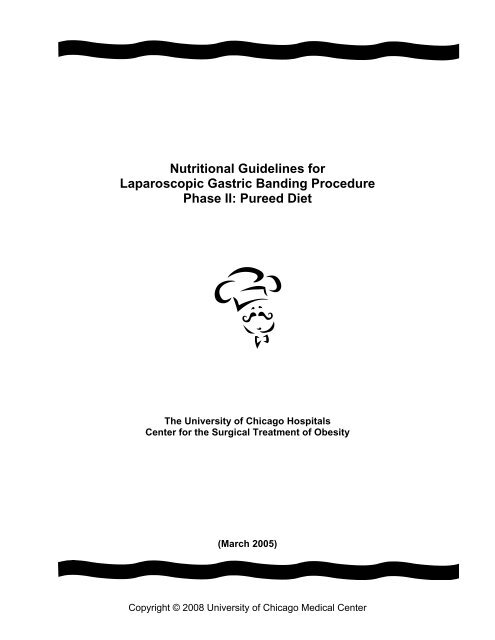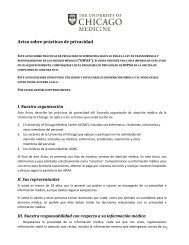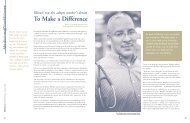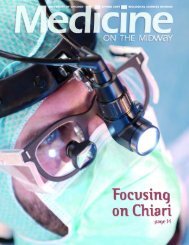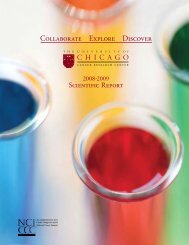Pureed Diet - University of Chicago Medical Center
Pureed Diet - University of Chicago Medical Center
Pureed Diet - University of Chicago Medical Center
Create successful ePaper yourself
Turn your PDF publications into a flip-book with our unique Google optimized e-Paper software.
Nutritional Guidelines forLaparoscopic Gastric Banding ProcedurePhase II: <strong>Pureed</strong> <strong>Diet</strong>The <strong>University</strong> <strong>of</strong> <strong>Chicago</strong> Hospitals<strong>Center</strong> for the Surgical Treatment <strong>of</strong> Obesity(March 2005)Copyright © 2008 <strong>University</strong> <strong>of</strong> <strong>Chicago</strong> <strong>Medical</strong> <strong>Center</strong>
Phase II <strong>Diet</strong> – <strong>Pureed</strong> Foods1. For approximately two more weeks, your new pouch will be swollen because <strong>of</strong> thesurgery. You will need to eat a pureed diet with a consistency <strong>of</strong> small curd cottagecheese, baby food or applesauce. “Mashing” certain foods or “chewing verywell” does not produce the correct consistency; your food must be pureed.This diet will allow the swelling to subside and will minimize the chances <strong>of</strong> foodparticles lodging in your stomach opening.Note: Many patients choose not to puree their food but instead eat foods that arealready a pureed consistency or considered acceptable by The Surgical Treatmentfor Obesity staff:Plain yogurt, drinkable yogurt, small curd cottage cheese, melted cheese,refried beans, plain quick/instant oatmeal, cream <strong>of</strong> wheat, grits, farina, plainscrambled egg, liver sausage, hummus, sugar-free pudding, stage I baby foodsTip: To save time and to avoid wasting food, many people puree food and then pourit into ice cube trays, let it freeze, and then place it into plastic bags. When it is timeto eat, simply microwave a few cubes and you have a quick meal.2. Each meal should contain no more than 2 oz. (1/4 cup) <strong>of</strong> food.3. Eat only three meals daily. Liquids must be consumed between meals only. Drinkingwhile eating may cause the food you have consumed to move through the pouchmore quickly, and may lead to overeating. Always wait at least 60 minutes after youhave finished eating to begin drinking.4. Eat only high quality foods. Healthy foods are a must! Filling your pouch with “junkfood” will not help you meet your daily nutrient requirements. Remember, thesurgery is only a tool – new eating habits and healthy lifestyle changes areabsolutely essential to your success at losing weight and keeping it <strong>of</strong>f.5. Maintain hydration. Drinking 6-8 glasses <strong>of</strong> low-calorie fluids daily will ensure youare adequately hydrated. The flowing are acceptable liquids:♦ Water♦ Low-fat Milk♦ Sugar-free Kool-Aid®, Crystal Light®, or iced tea sweetened with NutraSweet® orother sugar substitute.♦ Hot tea or c<strong>of</strong>fee sweetened with a sugar substitute.♦ <strong>Diet</strong> Snapple♦ <strong>Diet</strong> Lipton Brisk Iced TeaCarbonated beverages are not acceptable, as they may stretch thepouch, cause feelings <strong>of</strong> over-fullness, and may lead to vomiting!Copyright © 2008 <strong>University</strong> <strong>of</strong> <strong>Chicago</strong> <strong>Medical</strong> <strong>Center</strong>
Key Nutrition Components1. CARBOHYDRATESFoods with a concentrated supply <strong>of</strong> calories should be avoided. Read foodlabels for key words such as: sugar, brown sugar, sucrose, glucose, maple syrup,high fructose corn syrup, corn syrup, honey, molasses, mannitol, xylitol, andsweetened condensed milk. The closer they are to the beginning <strong>of</strong> the ingredientslist, the more sugar the product contains. Avoid products that have sugar listedamong the first three ingredients.Sources <strong>of</strong> Concentrated Sweets to Avoid• Desserts (cakes, cookies, pies, candy and candy bars)• Ice Cream, Sherbet, Frozen Yogurt, Frozen Ice• Sweetened breads and cereals• Sweetened canned, frozen, and dried fruit• Carbonated beverages• Sweetened fruit drinks and punches (dark juices have more sugar)• Sweetened milk such as chocolate milk and milkshakes• Jelly, Jam, Honey, Marmalade, Syrup• Gelatin• Sweetened gum2. PROTEINYou need to consume a minimum <strong>of</strong> 60 grams <strong>of</strong> protein daily. You must eatenough protein every day in order to stay healthy and lose weight. A commonmisconception is that if you eat protein you will gain weight. In reality, however, youwill not maintain weight loss unless you consume adequate protein. Your bodyneeds protein for brain functioning and energy. When you do not eat enoughprotein, your body will use its muscles for energy and retain its fat. Therefore, youwill not lose weight and you may feel sluggish.Although fruits and vegetables are important for good nutrition, during the first fewweeks after surgery it is more important to eat the higher protein-containing foods.Use this chart to select foods that will help you meet your protein goals.Amounts <strong>of</strong> Protein in Common Foods (grams per serving)<strong>Pureed</strong> Poultry/Beef/Fish/Pork 7 1 oz. (cooked)Plain scrambled egg 7 1 eggMelted Cheese 4-8 1 oz. (1 slice)Milk (2%, 1% or nonfat) 8 8 oz. (1 cup)Cottage Cheese (small curd) 8 ¼ cupYogurt (without seeds or skins) 8 8 oz. (1 cup)Nonfat powdered milk 8 2.5 TablespoonsRefried Beans 6 ½ cup (cooked)T<strong>of</strong>u 3 ¼ cup<strong>Pureed</strong> Vegetables 2 ½ cup (cooked)<strong>Pureed</strong> Fruit/Fruit Juice 0 ½ - ¾ cup juiceCopyright © 2008 <strong>University</strong> <strong>of</strong> <strong>Chicago</strong> <strong>Medical</strong> <strong>Center</strong>
Cream Soup 3 ½ cupTomato Soup 2 ½ cupPudding 3 ½ cupSugar-Free Gelatin 2 ½ cupSugar Free Popsicles 0 1 svgSugar Free Fudgsicles 2 1 svgFarina 2.5 ¾ cupGrits 3.5 1 cupOatmeal 3 ½ cupTo help you monitor the amount <strong>of</strong> protein you eat, it is important for you to keepprecise daily food records. Use food labels and the handouts we have provided tocalculate the amount <strong>of</strong> protein (grams) per serving.Tips to Increase Your Protein Intake* Double strengthen your milk (add 2.5-3 tablespoons <strong>of</strong> non-fat powdered milk per 1cup milk). If you have lactose intolerance, try Lactaid® or Dairy Ease®, which contain enzymesto help digest your milk. You may also try soy or rice milk. Add non-fat powdered milk or a protein supplement <strong>of</strong> your choice to any liquid orpureed food (cottage cheese, soup, yogurt, hot cereal, Sugar Free Carnation InstantBreakfast® (4g protein per packet). Sip on a protein drink between meals.3. FatsA moderate fat diet is recommended after surgery. Avoiding greasy, fried, high-fatfoods is important for your health and to achieve your weight loss goals. Fat alsodelays gastric emptying and nay contribute to feeling full for a prolonged period <strong>of</strong>time, and potentially lead to vomiting.It is recommended that you choose low-fat dairy products (milk, cheese, cottagecheese, yogurt). When choosing foods, the majority <strong>of</strong> the fat should come frommonounsaturated (canola, olive, and peanut oils, avocados) and polyunsaturated(corn, safflower, peanut, soybean and sunflower oils) vs. saturated (butter and otheranimal products) sources. Foods should be baked, broiled, or grilled. Remove theskin <strong>of</strong>f poultry before eating it. Choose to eat fish at least three times per week.Foods such as nuts and seeds are healthy snacks due to their healthy fat andprotein content, but are also high in calories and should be eaten in small portions.Trans fatty acids (TFA’s) are formed during the process <strong>of</strong> hydrogenation, whichturns liquid fats (oils) into a solid substance, such as margarine and shortening.Foods made from TFA’s are abundant in the American diet because they allowfoods to stay fresh on grocery shelves for a long time. Typical foods that containTFA’s are: doughnuts, french fries, cookies, crackers, snack chips, and many othercommercially prepared snacks and baked good. TFA’s should be avoided, as theyresult in unfavorable changes in your blood cholesterol levels. Humans do notrequire any trans fats in their diets, therefore, the goal for TFA consumption is ZEROgrams daily.Copyright © 2008 <strong>University</strong> <strong>of</strong> <strong>Chicago</strong> <strong>Medical</strong> <strong>Center</strong>
4. Physical ActivityAn active lifestyle after surgery is essential to your weight loss success. Your sizemay make it hard for you to exercise as much as you should at first, but the moreweight you lose, the easier it should get. You may begin a physical activity program,such as walking and swimming, approximately four weeks after surgery. Alwayscheck with your surgeon before starting any strenuous activities, such as weighttraining or running.Following two weeks on the pureed diet, you may begin adding s<strong>of</strong>t, low fiber foods toyour diet.Copyright © 2008 <strong>University</strong> <strong>of</strong> <strong>Chicago</strong> <strong>Medical</strong> <strong>Center</strong>


